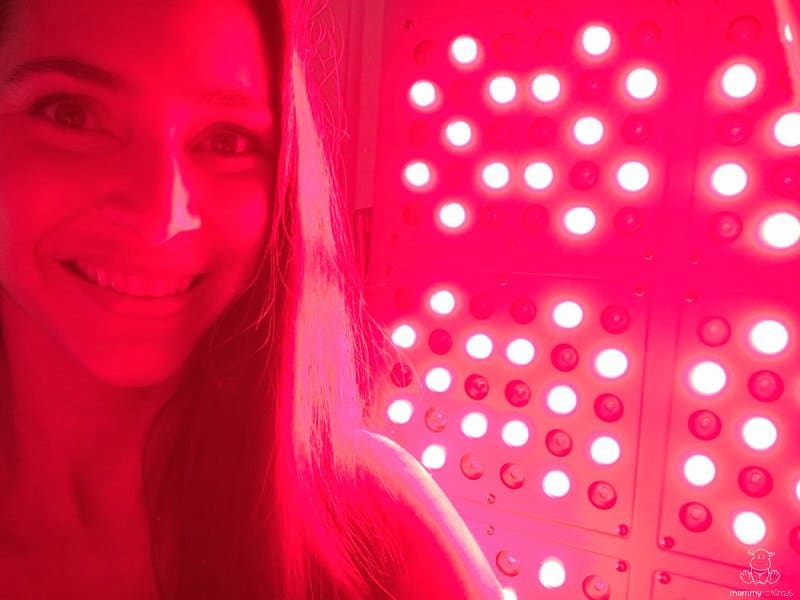
Inside: Red light and near-infrared light therapy stimulate collagen production, help fade stretch marks and scars, support muscle recovery, hormone health, and more. We’ll dive into why it works, plus what to look for in a light therapy device.
“I’m in.” <– Whether it’s standing in a cryotherapy tank at -280F degrees, spraying beneficial bacteria on my skin, or floating in 1,000 pounds of dissolved epsom salt, when Katie of Wellness Mama and I discover something new to try, that’s my first response.
That’s why when we found ourselves in front of a full-body Joovv red light therapy device at a biohacking conference, you know exactly what I said.
- What is Red Light Therapy? (Photobiomodulation)
- How does red light therapy work?
- 1. Increases Collagen Production and Skin Repair
- 2. Hair Growth, Thickness and Shine
- 3. Supports Detoxification and Circulation
- 4. Optimizes Metabolism and Energy Levels
- 5. Benefits for the Thyroid and Hormones
- 6. Supports Healing And Recovery
- My Experience With Red Light Therapy
- Why Joovv?
- Frequently Asked Questions
- Have you ever tried red light therapy?
You see, our bodies can “eat” light. If that sounds woo to you, I get it. I felt the same way until I started looking into the hundreds of high-quality (randomized, double-blind, placebo controlled) published studies on red light and near infrared light therapy.
Also called photobiomodulation, red light therapy is helpful for everything from thyroid function to wound healing. We’ll dive into the full list later on, but here’s a short preview:
- Increasing Collagen and Elastin Production – These are the main proteins that provide structural support for our skin. Collagen provides suppleness, while elastin provides elasticity. (2)
- Fat Metabolism – Although the exact mechanism is not yet fully understood, red light therapy increases the body’s ability to metabolize fat. It may be due to its ability to disperse (some say melt) adipocytes, which are cells that store fat. (3)
- Increasing Energy Levels – As we’ll discuss in the next section, red light therapy generates cellular energy, thus increasing overall energy levels.
- Detoxification Support – Red light therapy causes an increase in lymphatic system activity, which I talked about in this post on dry brushing assists with detoxification (4)
The science of how our bodies metabolize (or “eat”) light to achieve these benefits centers around something called cytochrome c oxidase, which we’ll dive into more later. But first, you’re probably wondering . . .
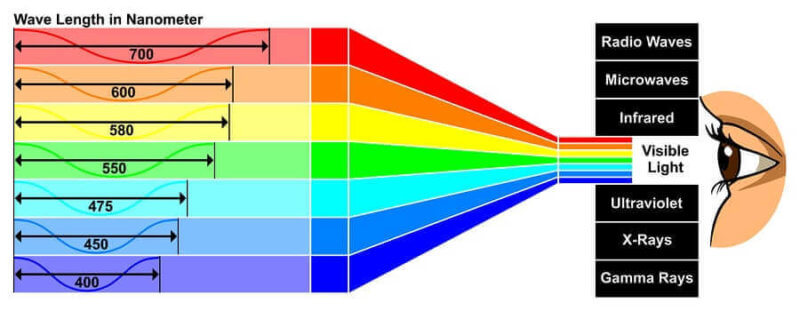
What is Red Light Therapy? (Photobiomodulation) ^
You’ve probably heard that exposure to blue light at night can reduce sleep quality, cause hormone imbalances, and contribute to weight gain and depression or anxiety, but what’s not as well known is that other wavelengths also have biological effects. I’m not just talking about the light that enters our eyes, either. Our skin can also sense light, and both forms of light exposure have a biological effect. (1)
Red light and near-infrared light, for example, have well-documented healing and rejuvenating effects on the body.
How does red light therapy work? ^
Short answer: Just like plants convert light energy into chemical energy via photosynthesis, our bodies have the ability to metabolize red and near-infrared light into a form of cellular energy – adenosine triphosphate – that is essential to restoring, repairing, energizing, and maintaining our bodies.
Long answer: Adenosine triphosphate (ATP) is often referred to as the “energy currency of life.” We can go for a period of time without food, water, and even air, but if our bodies were deprived of ATP for even seconds life could not continue.
The recipe for this “energy currency” hinges on an enzyme called cytochrome c oxidase. It’s the glue that makes ATP by helping oxygen (O) bind with nicotinamide adenine dinucleotide (NAD) and hydrogen (H) to form NADH, the hydrogen ions that make ATP synthase.
Unfortunately, when we’re stressed (hello modern life!), sick, or injured, our cells produce excessive amounts of nitric oxide, which “steals” cytochrome c oxidase by binding with it so that it can’t do it’s job. Without enough cytochrome c oxidase to help bind together the oxygen and NADH, our capacity to make ATP is reduced.
Without sufficient ATP, our body’s ability to make collagen, metabolize fat, synthesize hormones and perform other tasks diminishes. We started to feel tired. We find that we aren’t bouncing back from stress or illness as quickly. We aren’t able to repair and heal as well as we’d like.
Red light and near infrared light works by breaking the bond between nitric oxide and cytochrome c oxidase, thus freeing up the cytochrome c oxidase to make ATP.
Not just any light, though – you need the right wavelengths and intensity. Red light in the 630-670 nanometer range and near-infrared light in the 810-880 nanometer range are recommended because they have the most documented benefits.
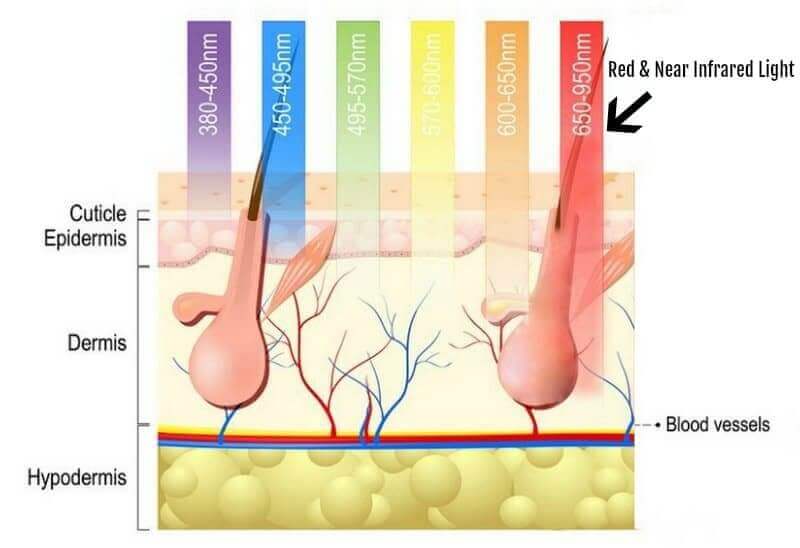
1. Increases Collagen Production and Skin Repair ^
As you can see in the image above, red and near-infrared light penetrate deeper into skin than other colors, which allows their healing wavelengths to:
- Improve skin clarity, tone and texture (3)
- Increase collagen (which provides suppleness) and elastin (which provides elasticity) (2)
- Assist with fading of scars (including acne scars) and stretch marks (5)
- Decrease inflammation
- Help with acne – One study found that light therapy helps by reducing inflammation and impacting sebum production. (3)
Several studies have also found red and near-infrared wavelengths helpful for healing sun damage. (11)
2. Hair Growth, Thickness and Shine ^
No, it won’t cause you to grow hair in new places (whew!), but several studies have found that red light therapy can increase hair follicle activity. For example, in this analysis, hair thickness, density and shine were improved with light therapy.
3. Supports Detoxification and Circulation ^
Photobiomodulation stimulates an increase in lymphatic system activity, which as discussed in this post on dry brushing assists with detoxification. (4) It also increases circulation via the formation of new capillaries, allowing more blood and oxygen to deliver nutrients throughout the body (6)
4. Optimizes Metabolism and Energy Levels ^
Although the exact mechanism is not yet fully understood, red light therapy increases the body’s ability to metabolize fat. It may be due to its ability to disperse (some say melt) adipocytes, which are cells that store fat. (3)
Also, I sometimes joke that coffee is like a hug for my brain, but it only yields a temporary benefit that can actually deplete energy levels if not consumed wisely. Our mitochondria, on the other hand, are the source of true vitality within our bodies. They’re the powerhouses that make our cellular engines run, and the more robust they are they more energy we have to work with everyday.
5. Benefits for the Thyroid and Hormones ^
Researchers have found that it also has a beneficial impact on thyroid function for both women and men. There is also some evidence to suggest it may increase testosterone production in men. (10) (12)
6. Supports Healing And Recovery ^
Because it stimulates the production of ATP that restores, repairs, energizes, and maintains our bodies, red light therapy can be helpful for:
Reducing discomfort in the neck, back and joints (7)
Faster wound healing (6)
Faster muscle recovery (8)
Enhancing athletic performance (9)
Video: My Experience with Joovv Red Light Therapy
Important note: Protective eyewear may be needed depending on which Joovv device you have and how you’re using it. Please see this article for more information.
My Experience With Red Light Therapy ^
I started using red light therapy during a really stressful time in my life several months ago. My husband and I drove our family through the night to close on a home in a new state, only to find out when we arrived that the seller had encountered a problem and we couldn’t buy the house.
The whole experience was incredibly draining, so I ordered a Joovv light to hang on my bedroom door. It’s nice and compact, which is great when you’re working with a small space. (I had to put my beloved sauna in storage until we have a permanent home, which will probably be about a year.)
With most things – healthy eating or taking a supplement for example – it usually takes some time and consistent use before change is noticeable.
That’s why I was pretty surprised when I noticed a surge in energy levels and mood after a week or two. I had more energy and was able to bounce back from daily stresses more easily, which is saying a lot because we were still dealing with some pretty significant challenges from our move.
I didn’t think to grab a lab work “snapshot” of my hormone levels and oxidative stress markers before starting because I wasn’t expecting to notice such a dramatic shift, but I’m absolutely certain that my hormone levels have increased overall. I’m not going to go into details on that, but trust me. 🙂
I’ve also noticed that I’m recovering from workouts more easily and my skin tone and texture have noticeably improved. I’m super interested to see how my skin and energy levels improve as I continue to use it – I’ll keep you posted!
My husband husband loves it, too . . . he says it makes him feel refreshed. He’s also using it to help with recovery as he works through an old sports injury in his ankle/foot area. (He had surgery on it years ago and it didn’t heal quite right, and lately he’s been working on improving strength and flexibility.)
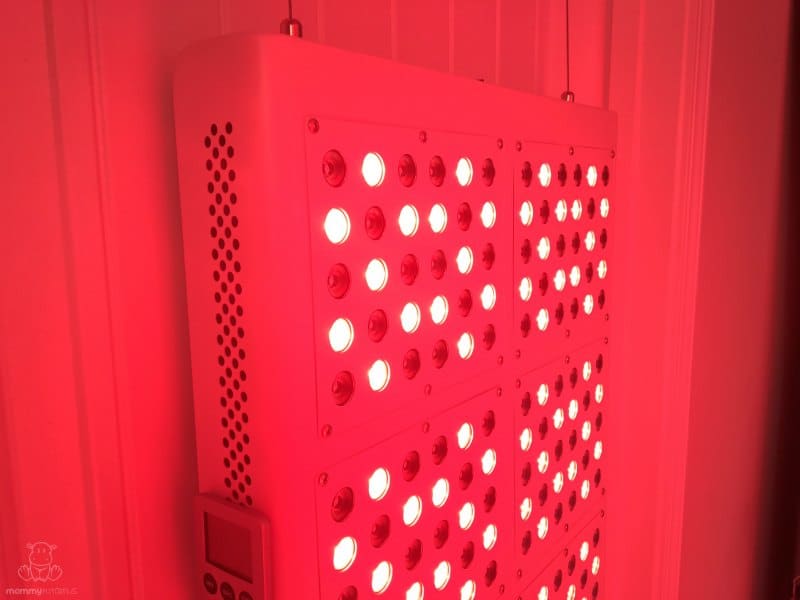
The bright bulbs generate red light (660 nm) and the dark bulbs generate near-infrared light 850 nm) , which is invisible to the eye.
Why Joovv? ^
There are four things I believe are most important when looking for a red light therapy device: optimal wavelengths, therapeutic-level intensity, the size of the area that can be treated, and a safe EMF rating.
1. Wavelength
Some devices don’t disclose what wavelength (or wavelengths) they use, and some do disclose them but incorporate wavelengths that are not considered to have much biological activity.
For example according to Dr. Michael Hamblin, who is an Associate Professor of Dermatology at Harvard Medical School, one of the most-respected researchers on photobiomodulation, and a member of scientific advisory board for Joovv, “Wavelengths between 700 and 770 nm are not considered to have much activity.” (13)
Joovv discloses the wavelengths they use – 660 nm for red light and 850 nm for near-infrared light. Both were chosen because the bulk of the scientific literature centers on their benefits, and you can get them separately or together. The 660nm range is better for collagen production and other skin benefits, while the 850 is better for deep tissue issues like muscle recovery, joint discomfort, etc. I opted for the version that comes with a combination of both.
Intensity (Therapeutic Results In Less Time)
Some devices use the right wavelengths, but they’re not powerful enough to create a therapeutic effect in a short amount of time.
Here’s how Wes from Joovv explained it at the Bulletproof Conference last year: If you turn on a faucet to fill a cup of water, you can let it fill drop-by-drop or turn the faucet on full blast. Both will get the job done, but one will take a lot more time. Joovv lights have enough irradiance (intensity) to deliver a therapeutic amount of light in under ten minutes.
Treatment Area
I bought my first red light therapy device years ago in an effort to help my husband recover from the surgery I mentioned above. I didn’t realize at the time that it was the correct wavelength for superficial skin issues but not deep tissue concerns. Also, although it had enough power, it wasn’t much bigger than a pen light and my husband gave up using it because it took FOREVER to complete a treatment. With the Joovv light, he can treat his entire body in less time than it takes to wash dishes after a meal (which he also does often – love him!)
Low-EMF – Joovv claims that at the recommended treatment distance their device is no-EMF. Earlier this year I invested in an EMF meter that is more precise than the Trifield meter I’ve been using for years, and I was able to confirm that even with the new, highly sensitive meter the Joovv showed zero increase in EMF’s when I turned it on and stood at the recommended treatment distance.
Frequently Asked Questions ^
Below are some of the most common questions I’ve been asked – if you don’t see yours listed please let me know in the comments and I’ll try to get an answer for you.
They work using different – yet interdependent – mechanisms that make them complementary with each other.
Red light therapy is like eating a nourishing diet that builds the body up, but instead of metabolizing food your body metabolizes light to create the ATP needed to restore, repair, energize, and maintain your body.
Sauna therapy uses a mechanism called hormesis – aka beneficial stress – to stimulate a “cellular cleanup mode” called autophagy. Basically, imagine a bunch of little Pac Man guys going throughout the body and eating up cellular trash and debris that’s been lying around.
Our bodies need ATP to do the cleanup, and interestingly the more cleanup our bodies do (through frequent hormetic stress like exercise, sauna therapy and intermittent fasting) the more robust our ATP function becomes, so as you can see they truly are interdependent.
If you’re wondering about near-infrared saunas, here’s what you need to know: The lamps/heaters that deliver radiant heat to the body (which is the point of sauna therapy) usually contain on a very small amount of the wavelengths that break the cytochrome c oxidase bond and free up the body to make more ATP. Near-infrared saunas are beneficial, but not in the same way as light therapy.
In general photobiomodulation is considered very safe, and although I can’t speak for all devices out there the light I use is considered safe for adults, kids, and even pets.
Protective eyewear may be needed depending on which Joovv device you have and how you’re using it. Please see this article for more information.
They have a lifespan of 50,000 hours.
The 660nm (red light) range is better for collagen production and other skin benefits, while the 850 (near-infrared) range is better for deep tissue issues like muscle recovery, joint discomfort, etc.
I opted for the version that comes with a combination of both red and near-infrared wavelengths. They have a 60 day free trial period, so if you don’t love it you just have ship it back in the original packaging.
This article was medically reviewed by Dr. Scott Soerries, MD, Family Physician and Medical Director of SteadyMD. As always, this is not personal medical advice and we recommend that you talk with your doctor.
Have you ever tried red light therapy? ^
What was your experience?
Sources for this article:
1. Cronin, Thomas, (2017) Seeing without eyes – the unexpected world of nonvisual photoreception. Retrieved from ScientificAmerican.com
2. Wunsch, A et. al. (2014) A Controlled Trial to Determine the Efficacy of Red and Near-Infrared Light Treatment in Patient Satisfaction, Reduction of Fine Lines, Wrinkles, Skin Roughness, and Intradermal Collagen Density Increase. Retrieved from PubMed
3. Avci M.D., Pinar et.al. (2013) Low-Level Laser Therapy for Fat Layer Reduction: A Comprehensive Review. Retrieved from PubMed
4. Hamblin, Michael. (2017) Mechanisms and applications of the anti-inflammatory effects of photobiomodulation. Retrieved from NCBI.NLM.NIH.gov
5. Ferraresi C et. al. (2012) Low-level laser (light) therapy (LLLT) on muscle tissue: performance, fatigue and repair benefited by the power of light. Retrieved from NCBI.NLM.NIH.gov
6. Abreu Chaves, Maria Emilia de (2014) Effects of low-power light therapy on wound healing: LASER x LED. Retrieved from PubMed
7. Joovv. 5 Clinical Studies that Demonstrate the Pain-Relieving Benefits of Red Light Therapy
8. Al Rashoud, AS et. al. (2014) Efficacy of low-level laser therapy applied at acupuncture points in knee osteoarthritis: a randomised double-blind comparative trial. Retrieved from PubMed
9. Baroni, BM et. al. (2015) Effect of low-level laser therapy on muscle adaptation to knee extensor eccentric training. Retrieved from PubMed
10. Ahn, JC et. al. (2013) The effects of low level laser therapy (LLLT) on the testis in elevating serum testosterone level in rats. Retrieved from ResearchGate.net.
11. 6 Clinical Studies That Support the Anti-Aging Benefits of Light Therapy
12. The Promising Evidence of Red and Near Infrared Light Therapy for Increasing Testosterone in Men
13. Hamblin, Michael R. Mechanisms of Low Level Light Therapy. Retrieved from PhotoBiology.info

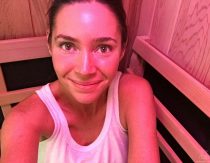
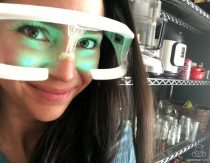
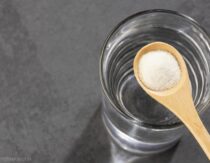

Great article! I loooove red light therapy.
VERY interesting! How long are your sessions?
I do 5-10 minutes each on my front and back sides 🙂
How do you occupy that time?
I dry brush and listen to an audiobook 🙂
How far away from the light do you stand?
About 6 inches
I just had a facial done that was for extra pigmentation that has happened over the last 6 months or so. I was AMAZED that after one treatment with light and their products resulted in so much fading of the darker areas. My husband could even tell the difference in dim light. Thanks for the review!
Do you know how this would compare to Sauna Space? My understanding is that it uses both red light therapy and the sauna for detoxification. Would that be a good option to gain all the benifits?
That’s a great question. From what I understand, the lamps/heaters that deliver radiant heat to the body (which is the point of sauna therapy) usually contain on a very small amount of the wavelengths that break the cytochrome c oxidase bond and free up the body to make more ATP. Near-infrared saunas are beneficial, but not in the same way as light therapy. Joovv goes into more detail about the differences here.
No sooner than I finished skimming the article you linked from Joov, Sauna Space posted an article comparing the differences, basically claiming what Joov wrote is untrue. https://saunaspace.com/saunaspace-vs-joovv/?utm_source=ig&utm_medium=social&utm_campaign=joovvvssaunaspace.
This is all very confusing for someone just wanting to get the best bang for my buck!
Hi Lisa! I am working on a reply for you but it may take a day or two because I squeeze my writing time in between making meals, homeschool stuff, etc. 🙂
Hey Lisa, here are my thoughts:
1. One of the reasons I chose Joovv is because Dr. Hamblin chose to serve on their scientific advisory board. He is Associate Professor of Dermatology at Harvard Medical School and one of the most-respected researchers on photobiomodulation. To me, that speaks volumes about what he thinks of their device, and it also shows that they clearly value his scientific input.
2. In the Journal of Biophysics article referenced, Dr. Hamblin goes on to say some things that I think clarify what he meant when he said that wavelength and power density were important, but the source was not. First, he clarifies that there are wavelengths within the range of which will yield results that are “likely to be disappointing.” While incandescent bulbs do emit a wider range of wavelengths, some of those are within that “likely to be disappointing” window. I’m not convinced that there is a known benefit for wavelengths above 950nm either, because in that same article Dr. Hamblin says that cytochrome c oxidase can only absorb light up to 950nm. The ability of cytochrome c oxidase to absorb light is the mechanism by which we think ATP synthesis is increased.
3. Regarding the optical window, in the study that graph was taken from Dr. Hamblin says that “Therefore, although blue, green and yellow light may have significant effects on cells growing in optically transparent culture medium, the use of LLLT in animals and patients almost exclusively involves red and NIR light (600 – 950 nm).” In other words, blue, green and yellow light do have a biological impact, but only in a transparent environment. Our skin is not transparent, so they don’t penetrate much and aren’t used therapeutically. I think Joovv’s graph was created with the therapeutic window in mind.
4. I asked Joovv about the irradiance calculation using the Megger data and am awaiting additional clarity from the manufacturer of the Megger Irradiance Meter.
5. Regarding EMFs, they have used shielded cords for over a year and have already begun the lengthy process of third-party independent testing. They are expecting to be able to publish results soon. From a personal standpoint, the number I want to see is the EMF field of an area before the device is turned on. Most buildings have some level of EMF, so it’s important to measure that beforehand and then note if there is an increase after the device is switched on. I took the exact measurements I just described using an EMF meter recommended to me by an engineer who is also an EMF expert, and there was zero increase in EMF emissions.
6. The PBM Dose test doesn’t make any sense to me. The point of LEDs is that they don’t get hot and therefore you can stand right next to them and soak in the healing wavelengths, so it doesn’t make any sense to measure their irradiance levels at 18 inches away. Joovv recommends standing 6-12 inches away.
Let me know if you have any specific questions. If I don’t know the answer I will do my very best to find out for you. 🙂
I have a SaunaSpace 4 light panel, for two years now. Its impeccable in craftsmanship, the only drawback is if you have small children, because the lights are hot. I wouldn’t be without mine, I also bought the single light which I place at my feet for red light in the evening and a gentle heat source in the winter (I live in Minnesota). For me this product is a two-for. I use it as a sauna and red light therapy. That said, I recently purchased a full body LED panel with 200 LEDs, but not by Joovv. From my research there are better choices for less money (with the 4 ranges of red and nir led lights). I would continue researching, Hamblin is amazing yes, research Dr. John Harvey Kellogg on incandescent who was one of the first pioneers in this field. Also research T. Karu and photobiomodulation and the 4 peaks ranges. I would look at Red light Man for alternatives and comparisons to led panels, also Ray Peat forums has a link to the same.
Are you aware of any research regarding red light therapy and melasma, especially for fair-skinned women? I’m in my early thirties, have never been pregnant or been on birth control, and have had the condition for about five years. IPL treatments, topical prescription creams, and a long-term paleo/Whole30 diet have not helped. Hormone tests have come back normal, I protect my skin when I am outdoors, and melasma does not run in my family. Red light therapy sounds like it might be a step in the right direction for total body healing, but my husband is afraid of me trying out another “fad” and worries about possible long-term repercussions regarding red light therapy (i.e. in 20 years, scientist discover that red light therapy causes cancer.) I am curious about what information you might have encountered in your research regarding melasma and/or safety. Thank you.
I’m so sorry to hear that it’s been such a long road of recovery!! I can completely empathize and it’s so draining. I can’t speak to red light therapy (though I wouldn’t be surprised if it helped significantly), but just wanted to drop a quick note re: paleo/whole 30. I have had significant autoimmune disease, which I’ve healed almost entirely through food, and I started out with paleo. Paleo helped a bit, but I plateaued pretty quickly. It was a switch to GAPS/keto, both of which emphasize loads of healthy fats, that finally kicked healing into high-gear for me. GAPS is explicitly for healing, keto is more of a day-to-day way of eating (probably way too boiled down explanation, but there you go). Heather’s friend Katie over at Wellness Mama has some good keto info recently, particularly for women and the Heal your Gut Cookbook is my favorite for GAPS overview and starter recipes! I do wish you the best of luck!!!
I am wheelchair bonded so can I still do a session if yes how?Thanks
The folks at Joovv might have some suggestions for how it could be configured horizontally for easier use.
i bought a JOOVV max combo and it arrived about 3 weeks ago. my 94 yr old father has been sitting in front of it, 10 minutes on each side, twice a day. i was standing in front of it, nude, also twice a day, 10 minutes on each side. until i left town for a job a week ago
the reports from home are fairly glowing. dad went to his senior center on tuesday and the chair yoga teacher texted me that everyone was “in awe at how fast he was moving around!” the people there don’t know anything about his red light therapy so there’s no chance that they were influenced by “placebo”
he told me that he had gone down to the cellar, done some work and come back upstairs and “it was surprisingly easy!” our cellar stairs have become very difficult for him in the past year and he hasn’t’ been going down there, which is sad because it’s his lair.
he also said that at his friday PT, he did all 30 reps of his exercises without taking any breaks.
my boyfriend, who is skeptical about these things, asked me “what’s the red light supposed to do anyway?” i asked what he had been noticing since he’s home wth dad and he said dad had much more energy. he’s convinced that it’s the light and he’s started standing in front of it himself and even wants to buy a second one so that we can stand between them in a light sandwich!
dad’s been waking up early and grabbing his weights for morning exercises. his home work out coach tells me she’s had to up his weights.
i’ve been feeding him homemade, nutrient dense organic foods for 2 years and filling him with supplements and i’ve seen some improvements but i think the light enables the cells to use the supplements and nutrients more efficiently. when asked if he thought it was the lights that were causing his recent improvement, dad said wisely that he thought it was the synergy between the lights and “everything else”
he has a really crippled knee, diastolic heart failure wth a preserved EF of 50%, macular degeneration, hearing loss and numb finger tips. we’ve seen a partial reversal of his AMD with improved circulation but i believe the lights will accelerate the improvements. his knee isn’t as sensitive lately so he’s able to move around a lot more and obviously he’s gaining muscle.
when he sits in the light at night, it looks from the outside, as if the house is on fire. i’m hoping the neighbors don’t call the fire department
i debated for a couple of months- which one to get? what size?
i was going to get the small, then decided to treat us to the standard size. ultimately i splurged on the max size. i have no regrets- other than not buying it sooner!
Hello,
What great information! Do you think it’s safe to use while pregnant?
Thanks 🙂
Hi Tiffany, here’s what Joovv says: “Dr. Michael Hamblin, arguably the world’s leading researcher in the field of light therapy, is on our scientific advisory board. He believes that red light can actually be very beneficial during pregnancy due to the prevalence of stem cells. Having said that, there is no published clinical literature to support this. Therefore, it might be beneficial to discuss this with a physician experienced with light therapy.” https://support.joovv.com/article/kjzg5lyv0q-can-i-do-treatments-while-pregnant
Hi, Heather!! Thanks for your info. As always another great article. Which exact model did you get? Have you ever researched the company Biolight? Biolight is who my Kinisiologist recommends. Also, have you done any research on the Red Light therapy that Clearlight is adding to their Sanctuary Saunas? I’m about to purchase their Sanctuary 2 in Basseood and it seems like a good fit to add their red light therapy. Do you have any opinions on that? Pam from Clearlight said science shows they’re a perfect fit to do in the same session. Thanks so much for all your diligent research.
Hi Heather,
You quote Dr. Hamblin as saying “Wavelengths between 700 and 770 nm are not considered to have much activity.” If the Joovv light has only 660 nm for the red light, is the red light therapy effective? Or is it just the near-infrared that’s working? This is very interesting.
Hi Nancy, I’m not sure I understand your question so if this doesn’t clarify things for you please let me know. Within the red light spectrum a certain range (630-670 nanometers) has the bulk of research behind it showing benefits, and within the near-infrared the 810-880 nanometer range has the most research-documented benefits. Between those two ranges is the 700 range, which doesn’t appear to have the same level of biological activity.
The Joovv combo light comes with two bulbs – one that is 660nm and one that is 850nm, so you’re getting two wavelengths in the ranges that are supported by research.
You answered my question perfectly! Thanks for clarifying that. And thanks for all the great information you post. You save me so much time by doing all the research on the subjects you write about. I don’t know where you find the time to do it all, but I’m glad you do!
I’ve been looking at the red light therapy lights too! They seem like the same thing with the same wavelengths but are much cheaper. I think i read on wellness mama that they were the 2 options but i know that she uses the Joovv even though the red light therapy company was an option she recommended in her article. Do you know why the Joovv is better? I can’t get a clear answer from joovv and the red light therapy company says it’s better and cheaper but looks like same wavelength. Thanks for your input!!!
Thank you for this info!! Planet Fitness has a red light and I was wondering if you knew about it and what the about of nm’s are with it? I just started using it there but then read your article and am now questioning if it is safe or beneficial from this source. Thanks!
I’m sorry but I’m not familiar with the device they use. Maybe they can tell you what wavelength is emitted?
My sauna has chromotherapy lights installed. I wonder if the red light from that would be somewhat comparable to the unit you have? It only comes from the top so may not penetrate as deeply.
My sauna has chromotherapy as well, however it’s not very strong in terms of irradiance.
Is the time frame if therapy the same for kids as it is for adults? Also, did you say daily? As for eye wear for those who prefer to wear some…what do you recommend?
Yes, the time is the same. I do 10 minutes on each side but have gone up to as much as 15 minutes – after 15 minutes there isn’t much of an increased benefit because (just like with food) your body digests multiple “meals” per day better than one huge one. Joovv recommends at least six hours between sessions. I have done up to two a day, but I usually only do one. As for eyewear, I think tanning goggles are what people usually use.
This is really awesome! Do you recommend wearing any face serum or body lotion while using the red light therapy. If so, what do you recommend. I’m in my 50’s so looking to reduce wrinkles and improve collage and elastin production. Thanks for your feedback and for writing this great blog!
Eeek! Wish I could edit my question above Lol I just peaked at the website and I see 3 diff sizes…would the smallest size work in a (laundry) closet and do the same light therapy needed for a “session”?
I’m not sure I’m totally understanding your question so if I need to clarify please let me know, but the differences between the three sizes is the overall treatment area. The mini has a 25″x18″ area, the original has a 48″x18″ area, and the max has a 63″x26″ area. You might find this page helpful in comparing the different sizes.
Heather, what size do you show in the video? Is it one big one or have you combined several to make it that big?
Can you tell what type of bulbs can be used for red light therapy at home?
Hi! I’m really interested in red light and near infrared therapy! It’s such amazing technology.
Do you think it is worth getting the Joovv Mini? I’m mostly wanting it for skin/collagen and help with sleep and deep tissue/joints when needed.
Thanks for all the great information!
I haven’t tried the mini but I really love my Joovv and use it almost everyday 🙂
Hi Heather! I do not think you mentioned what size Joovv you have? It looks like maybe the Duet? Budget is only going to allow for the mini for me at this point but I am still excited to try. Also, can you explain how it is able to hang from a door if it needs an outlet? The cord just hangs on the ground in front of the door? Or do you unplug it and plug it in only when you need it?Thanks!
Hi Becky, I have the quad because my husband is 6’2 with a wide frame and he uses it after workouts. The larger version allows him to reduce his overall treatment while still getting his whole body. 🙂 Ours hangs from our bathroom door and plugs into a nearby outlet. We sometimes leave it plugged in and sometimes unplug – it doesn’t get in the way when we leave it plugged in.
Hello! I just got my Joovv set up two days ago and excited for the possibility in healing for me. Given The 60 day guarantee return policy, I’m wondering if I’ll even notice a change in that time frame if consistent daily. When did you notice definite change, and how about now (which I’m not sure how long that is) Thank you!
I’m not exactly sure how long it took me to notice a difference – a few weeks, I believe.
What is your input on the red light beds? There’s a local tanning place that offers this service. I will ask them about the nm but what other things should I look for?
I just wanted to let you know that I read about the studies on the Joovv page and one of them was very interesting. These are the results of applying green tea with a cotton ball 20 minutes before the light therapy. https://www.ncbi.nlm.nih.gov/pubmed/19817517
RESULTS:
Rejuvenated skin, reduced wrinkle levels, and juvenile complexion, previously realized in 10 months of light treatment alone were realized in 1 month.
I was just wanting to be sure the combo panel of NIR and red lights is ok for kids. Were getting one for me and my husband. My daughter has eczema and I’d like for her to try it out to see if it can help her skin.
It is considered safe for adults, kids and even pets. One of my children broke a bone recently while doing handstands and is using the Joovv to support healing. 🙂
Hi! I just watch your video , loved it. Can you tell me if you use only the red light or just the NIR separate or both at the same time when you do your 20 min. front and back, Do you wear glasses to protect your eyes? if you do ,does it have the same healing effect , as if you do not. Thank you so much for taking the time to read this e-mail, I just purchased one and I am really excited to start using it. Love your web-site and love to see you and Wellness mama together. Looking forward to hear from you.
Lisa
Hi Lisa, I use the combination light, which has both red and NIR. In terms of timing, I do 10 minutes front and then 10 minutes back. According to Joovv, “Eye protection isn’t necessary, but we don’t recommend looking directly at the LEDs initially, as it can be uncomfortable until your eyes are accustomed to the light. For this reason, we recommend closing your eyes until you find that it’s comfortable to open them.”
Red light gives energy to body. Thanks for posting useful information.
How much is it? where can I buy it if I want to? The Video & information is interesting,
Hi Shirley, the price depends on the model you purchase. Here’s a link to the different options.
Hey Heather!
Loved your write-up on red light therapy and saunas.
I just got a Clearlight 2 as well. Amaaaazing.
I’m wondering if you’ve done any research on Clearlight’s red light tower and how it compares to this model you have experience with?
Thank you!! 🙂
I haven’t compared them directly but I know Clearlight spent years developing their red light tower to get things just right in terms of power and performance, and if I could combine the two into one session I totally would. Usually I pick one or the other to do most days. 🙂
Awesome. Thank you So much for replying. We did end up buying the sanctuary 2 with the redlight tower. We use them almost everyday. 🙌🏼 The shipping was a nightmare but I know it was out of their control. Interestingly enough right around the time I got the redlight I started to drop the 20 lbs I couldn’t loose after baby number 3. And I didn’t change anything else. So interesting…
That is interesting!
Hey Heather,
I am trying to watch your video on Red light therapy and ads keep popping up and its impossible to view, is there any way I can watch it without ads?
Any idea if 1 can do red light therapy while breastfeeding?
According to Joovv, which is the device I use, “As there has been little clinical research done on red light therapy treatments for pregnant or nursing subjects, do not use the device if pregnant or lactating before consulting with your healthcare provider.”
Dear Heather.
Nice article, but I have some remark.
Why do you use term “visible light”? Have you ever seen invisible light? Using term “visible” suggests there is also kind of “invisible” light. Light by itself means something which is visible. Everything out of 380-780 nm is radiation, and could be UV, IR or e.g. Gamma. But inside this given wavelenght it is just light. Adjective “visible” is totally redundant. What do you think?
Best regards
Michal
Hi Michal, I think that it’s commonly accepted that there are lightwaves we can’t see, just like there are colors we can’t see (but some animals can). I the phrasing below from the University of Arizona accurately reflects my perspective:
“The Visible and Non-visible Light Spectrum
As you can see from the illustration above, visible light is only a very small portion of all light waves. You may ask yourself why is it that we only see the “visible” portion of light? If you study the illustration above, you will see at the earth’s surface almost all the wavelengths with any significant energy are visible (see the green peak). There are some very small amounts of ultraviolet and infrared wavelengths that are present. In some cases, insects and other animals have adapted to see with those wavelengths.”
Is this safe for post-Caesarian recovery? OK while nursing?